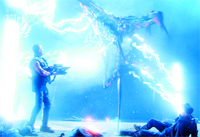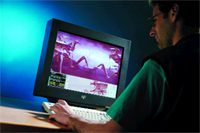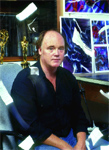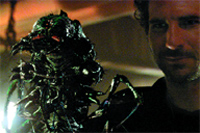BERKLEY, CA - In 1983, Phil Tippett finished his last shot on Star Wars: Return of the Jedi and then ventured east to his Berkley garage to start his own visual effects company called Tippett Studio. He had gone from a 25-year-old stop-motion animator on George Lucas' Star Wars IV: A New Hope to Industrial Light & Magic's creature shop supervisor when he decided it was time to run his own boutique visual effects enterprise. Twenty-seven years, 36 feature films, two Oscars (for Jedi and Jurassic Park) and thousands of effects shots later, Tippett finds himself celebrating his studio's 20th anniversary by making his directorial debut on the feature film Starship Troopers 2: Hero of the Federation.
Tippett says the reason it has taken him so long to direct a feature is because the kind of things he likes to do are a little off the Hollywood radar. "Basically, Starship Troopers was the first thing anyone let me direct and that came down to the fact that we'd make the movie for the budget."

The Tippett team was able to recycle bug characters from the 1997 Starship Troopers film. Originally created in Softimage 3D, they were updated for the sequel using Alias Maya.
|
VISUAL EFFECTS
Troopers 2 visual effects supervisor Eric Leven says that this movie offers the classic challenge of producing champagne effects on a beer budget. "When we worked on the first Starship Troopers movie it had a big effects budget to produce 220 effects shots over 14 months with a crew of 100."
"Everything was a challenge," he recalls. "We had done some small jobs but we
had to set up a whole new pipeline and a batch rendering system to handle a crew of 110 people."
At that time, Tippett Studio used Softimage 3D to build the models and Pixar RenderMan for rendering. Leven's crew taught themselves Alias Dynamation, a particle systems application to do the bug swarming behavior. "This was stuff that nobody had ever done before," Leven says proudly. They also had to build tools to convert Softimage files into a format that RenderMan could understand.

A blend of hardware is in place at Tippett Studio, including SGI, Linux, Mac and PC gear.
|
The software guys, he says, wrote shaders from scratch to get specific looks for the different classes of bugs. "The warrior bug had a sort of dusty high gloss sheen," describes Leven. "Hopper bugs have this iridescent quality. Plasma bugs had slimy, transparent sacks that can shoot glowing plasma out of their butt. You had to be able to blow holes in all the bugs and have blood come out. All of these things had to be figured out."
Eight years ago, Leven recalls, there was virtually no interaction between the CG characters and the live action plates. "A live person became a CG person when impaled," he explains casually. "No one picked up a bug."
On Starship Troopers 2 it's the total opposite. "There's a lot more interaction between the bugs and humans," Leven says, crediting the in-house match-move team. "More than half the camera shots were hand held. We would have been scared to match-move CG and live action shots like that before."
They were able to recycle the original models, Leven notes, importing and updating them in Alias Maya. He adds that they weren't able to import the animation, but they knew how the bugs moved and redid all the animation by hand.
"One of my favorite shots," Leven says excitedly, "was added in post production. It was never budgeted. At the end of the movie the heroine is taking off in a space ship leaving the planet. The hero is at the top of this building, comped into a motion control shot of the outpost built as a miniature and fighting off hundreds of warrior bugs. What's fun is even when visual effect people see that shot, they get that the bugs are fake, but nobody notices the guy is a CG digital double.
"The speed we had to move in post production was the main challenge with Troopers 2. It doesn't sound sexy but we did 120 effects shots in five months with 16 people, many of them right out of college. That's the big deal."
To really appreciate the production accomplishment, consider the first Starship Troopers, released in 1997, was budgeted at a cool 100 million. It earned around 55 million domestically and grossed 120 million worldwide. Starship Troopers 2 has at least half as many effects, many more complex than the original, with a total budget of around seven million.

Starship Troopers 2 is the first feature directed by Phil Tippett.
|
One of the big pluses for Leven was the intense collaboration with Tippett as director. "Supplying all the effects means there's consistency throughout the picture. Also on this picture Phil would be editing and discover he needed another shot to make a scene work, he'd would come over and we would build the shot, output it and edit it right in."
Most of Troopers 2 principal photography was lensed with the Sony CineAlta 24p HDW-F900 first-generation HDCAM with a 1920 x 1080 resolution. Since the Panasonic AJ-HDC27 VariCam can shoot as high as 60fps and as low as 4fps it was used for over- and under-cranked effects shots. There was also some miniDV footage used in some scenes.
Leven says working in HD does have advantages. The slightly lower resolution 1920 x 1080 compared to 2K for film takes less time to render. It works well for greenscreen shots, you've escaped the vagaries of lab chemistry affecting how the film looks, and you've knocked out the extra task of transferring all that footage via telecine.
Dan McNamara, head of operations at Tippett and another ILM alumni, says with this being the studio's first HD feature they wanted to leverage their existing feature production technology and integrate the HD production into their existing Irix and Linux pipeline.
The studio is a blended hardware shop with SGIs, Linux, a large installed base of Macintosh workstations and a few Windows boxes for special purposes. Tippett Studio uses mostly off-the-shelf apps like Apple's Shake and Alias Maya for production and writes their own code to get all the hardware and software talking to each other.
GETTING TECHNICAL
When Phil Tippett first founded his studio it was primarily a stop-motion production facility, but Jurassic Park changed all that.
"Jurassic Park was originally intended to be shot with stop-motion photography," says Tippett. "Dennis Muren [at ILM] was conducting these computer graphics tests where he had a whole herd of dinosaurs running across the screen. When the camera got real close they held up pretty good, so Spielberg decided to do all the dinosaurs that way." Muren still wanted Tippett involved and Jurassic Park became the watershed film that evolved the studio into a stop-motion and state of the art CG shop.
Tippett says there are two aspects to being on the bleeding-edge technically: "A great deal of having technical prowess is about functionality, about things running more smoothly. What you produce is actually the tip of the iceberg. Functional issues, like how do you get the dailies out efficiently, are critically important. So that something that took a hundred hours to render and that now takes 20 minutes, becomes very important. There's also all the research and development. Making muscle systems to make a character look more believable. All of this is driven by the specific requirements of the script and director."
Equally important, he says, is the other creative aspect where you spend "most of the time breaking the computer and getting it to do what it was never intended to do."

Most of Starship Troopers 2's principal photography was shot using Sony's CineAlta camera.
|
INFINITESTORAGE
SGI systems were adopted in those early years because it was the only way to do high-end CG. Over the years Tippett upgraded their SGIs and last year installed the most ambitious iteration of SGI gear, the InfiniteStorage storage area network (SAN).
"We did an assessment of our technology early in 2002," says McNamara. "We talked to SGI for about a year in terms of designing the system. We were seriously considering going a different route, then circled back to SGI."
Tippett had a legacy system that included SGI Octane2 workstations, an Origin 300 file server, an Origin 2100 server being used as a backup metadata server and an SGI TP9400 storage array. Upgrading added an SGI TP9500 storage unit, two 8-processor and one 4-processor SGI Origin 350 metadata servers, and two 16-port Brocade Fibre Channel switches. The new system gives them 18TB of storage, enough for multiple feature films at one time.
To bring in this kind of architecture with different tiers to it is the big benefit of the SAN, says McNamara. The artists can work, backups and maintenance can occur, the renderfarm can be building shots and the film recorders can be outputting footage, all at the same time.
Jim Farney, senior marketing manager for media industries at SGI, points out that the InfiniteStorage name is not just marketing hype. The system is scaleable up to 18 exabytes. For the "storage challenged," an exabyte is 1024 petabytes and a petabyte is 1024 terabytes. "Which is more storage," he says proudly, "than has existed since the beginning of time."
The point about InfiniteStorage is that it is not just a system but an environment where multiple systems integrate and co-operate. SGI's 64-bit clustered extended file system (CXFS) can scale files up to nine million TB and resolves the network data bottlenecks that can occur with Direct Attached Storage (DAS), Network Attached Storage (NAS) and a traditional Storage Area Network (SAN).
Tippett started using the new system in June 2003. "Matrix Revolutions was the first project to use it," recalls McNamara, and now of course all the shows are on it." Business wise, he says, it's a big advantage to be able to run multiple large projects at the same time.
For Troopers 2, he says, they toyed with the idea writing the HD footage directly onto the SAN, writing across the multiple Fibre Channel system, running mirrored dual link RGB to the servers and remote writing across the private network. But they figured that might be pushing it. Maybe, hopes McNamara, when HD becomes more prevalent and SGI improves the drivers, that would be a realistic possibility.
Instead Tippett evaluated a number of digital disc recorders (DDR) and they opted to build their own custom machine. "We had very specific features we wanted and didn't want to pay for features we didn't need," McNamara explains. "So we worked a development deal with SpecSoft to build the unit and write the software for SD and HD capture. This way the machine is open source and under our control based on a Linux system that we understand."
EDITING
Editor Louise Rubacky did the offline on an Avid Film Composer at Tippett Studio and final post was done at Post Logic on a Quantel iQ.
Post Logic editor Matt Johnson says the Tippett people were asking questions about the capabilities of the iQ two months before online editing. "They were editing on an Avid and wanted to know what kind of EDLs to use. They wanted to add some film grain to some scenes and reposition shots. I never blew things up past five percent, but the HDCAM can handle it and we did quite a few on the picture."
Tippett delivered all the effects footage on HDCAM instead of 2K frames on the hard drives they usually provide for a film project.
"It was more expedient since the rest of the movie was shot on HDCAM," notes Johnson. "It allows the editor to cut it on the Avid and have it reflected in the EDL during the online."
Troopers is currently set for a pay per view release on the Starz Action Channel at the end of April and there's a DVD release in June. Tippett says they just made 50 prints for theatrical release in Japan with potentially more prints for South Korea.